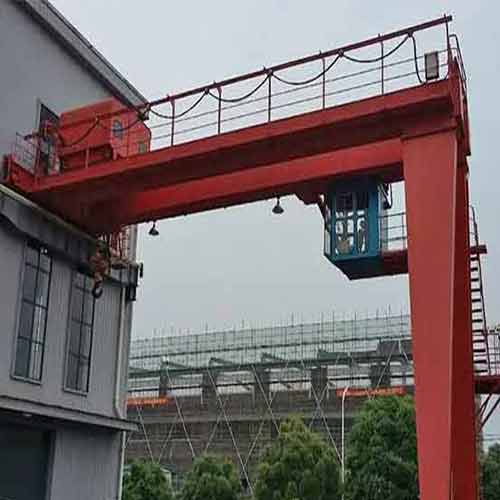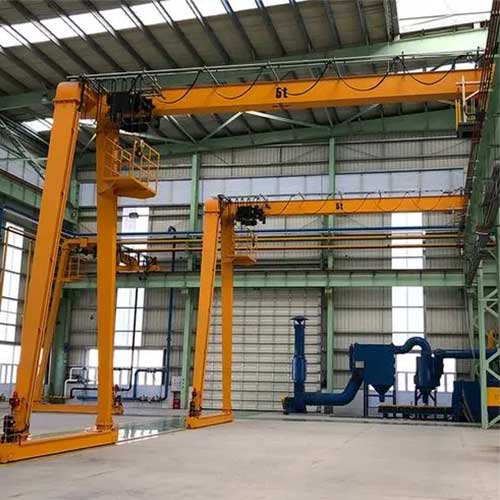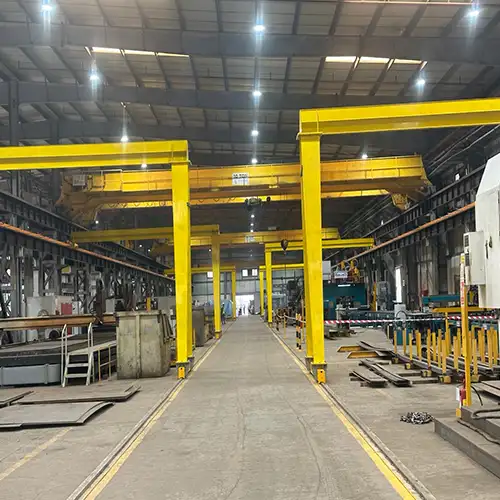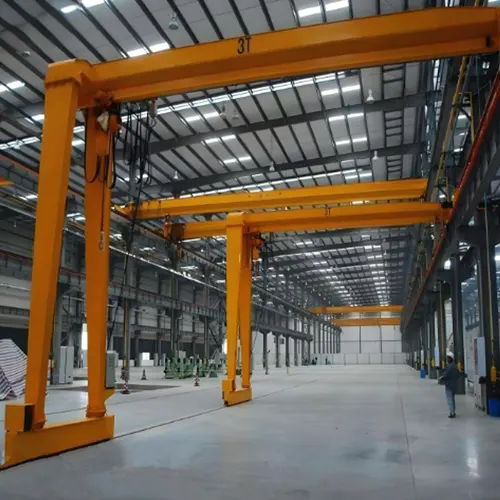Semi Gantry Crane for Sale, Tailored Semi Gantry Crane Types & Designs
Semi gantry crane overview. All on semi gantry crane types & designs for wide industrial applications. Get 3 ton, 5 ton, 10 ton, 20 ton semi gantry crane & price.
| Crane type | Semi gantry crane |
| Crane capacity | 1 ton -35 ton |
| Lifting height | As your request |
| Crane span | As customer requirement |
Category: Full& Half Gantry
Your Trusted Semi Gantry Crane Manufacturer & Supplier
Semi Gantry Crane for Sale, Tailored Semi Gantry Crane Types & Designs
Comprehensive Guide to Semi Gantry Cranes: Cost-effective Semi Gantry Crane & Semi Goliath Crane 1 ton to 35 Ton
Semi gantry crane overview. All on semi gantry crane types & designs for wide industrial applications. Get 3 ton, 5 ton, 10 ton, 20 ton semi gantry crane & price.
Comprehensive Guide to Semi Gantry Cranes: Elevating Your Material Handling Efficiency
When it comes to material handling, efficiency and precision are paramount. Enter the semi gantry crane—a unique solution that combines the best of two worlds, offering a versatile and adaptable approach to lifting and positioning loads. In this comprehensive guide, we'll dive deep into the world of semi gantry cranes, uncovering their design, advantages, applications, and much more.
A semi gantry crane, also known as a half gantry crane, stands out in the realm of lifting equipment due to its distinctive design. Unlike full gantry cranes that rely on two vertical legs for support, semi gantry cranes feature a single leg, with the other side utilizing an existing support structure, such as a wall or column. This asymmetric structure offers a blend of stability and adaptability that makes semi gantry cranes a valuable asset in various industries.
The Advantages of Semi Gantry Cranes
Why choose a semi gantry crane over other material handling solutions? The advantages are numerous:
- Adaptability:Semi gantry cranes excel in industries with limited floor space. Their design allows for strategic placement to optimize workflow, making them ideal for confined work areas.
- Precision:With one leg firmly grounded and the other utilizing existing support, semi gantry cranes provide exceptional precision in load positioning. This level of accuracy is invaluable in applications that require meticulous alignment.
- Load Capacity:While not matching the towering lifting capacity of full gantry cranes, semi gantry cranes are no slouch. They can handle moderate to heavy loads, making them versatile for various tasks.
Semi gantry cranes for sale are innovative lifting solutions designed to optimize material handling operations. In this section, we'll peel back the curtain to unveil the design of semi gantry cranes, explore their distinctive asymmetric structure, and delve into the key features that make them stand out in the world of material handling.
Unveiling the Semi Gantry Crane Design
At first glance, a semi gantry crane may appear somewhat unconventional compared to its full gantry or overhead crane counterparts. The primary feature that defines a semi gantry crane is its utilization of an asymmetric structure. Here's how it works:
- Single Leg Support:One side of the crane features a robust vertical support leg firmly grounded on the floor. This leg carries a substantial portion of the crane's weight and provides stability.
- Existing Support Structure:The other side of the crane doesn't rely on a vertical leg but instead utilizes an existing support structure. This structure could be a wall, column, or any other secure fixture in your workspace.
- Bridge Structure:Suspended between these two support points is the horizontal bridge structure that carries the lifting mechanism. This bridge is where the magic happens, allowing the crane to move horizontally along a rail system while lifting and positioning loads with precision.
Asymmetric Structure: How It Works
The brilliance of the semi gantry crane lies in its asymmetric design, which offers the best of both worlds:
- Stability:The grounded leg provides stability, ensuring that the crane remains firmly anchored during lifting and lowering operations. This stability is critical, especially when handling heavy loads that require precise placement.
- Adaptability:The absence of a second leg on one side offers unmatched adaptability. The crane can be strategically positioned to optimize workspace usage, making it an ideal choice for industries where floor space is at a premium.
- Key Features that Set Semi Gantry Cranes Apart
Semi gantry cranes come packed with features that set them apart as versatile material handling solutions:
- Optimized Workspace:Their adaptability makes semi gantry cranes perfect for industries where every inch of space counts. They can be placed along walls or other structures to maximize the use of available floor space.
- Precision in Load Handling:The asymmetric structure provides precise control over load positioning, making semi gantry cranes ideal for applications that demand accuracy, such as manufacturing and assembly.
- Moderate to Heavy Load Capacity:While not matching the colossal lifting capacity of full gantry cranes, semi gantry cranes are no lightweight. They can handle moderate to heavy loads, making them versatile across a wide range of tasks.
As we move forward in this guide, we'll explore the practical applications where semi gantry cranes shine, helping you identify how this unique lifting solution can elevate your material handling operations.
Types of Semi Gantry Cranes
Semi-gantry cranes can vary in terms of crane girder design, cantilever design, application environment, and application conditions to meet specific operational needs. Here are some of the main types based on these criteria:
Crane Girder Design:
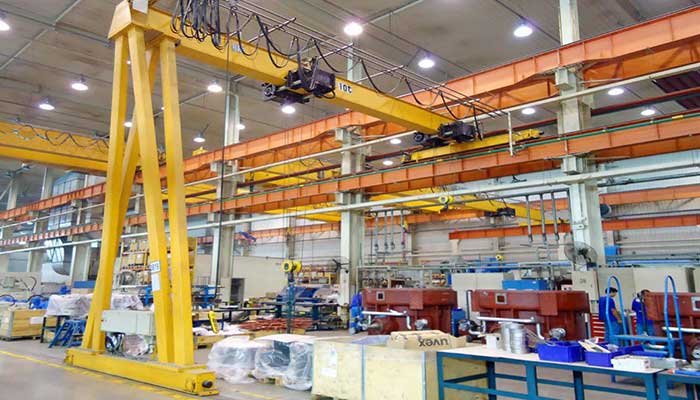
Box Girder Semi-Gantry Crane:
These cranes feature a box-shaped girder, which offers increased structural stability and resistance to deflection. Box girder designs are often used when heavy loads need to be lifted with precision.
Features:Box girder cranes provide increased structural stability and reduced deflection due to their box-shaped girder design. They are robust and suitable for heavy-duty applications.
Benefits:High precision and stability make them ideal for tasks that require accurate load positioning and movement.
Typical Applications:Used in industries where precision is crucial, such as aerospace, automotive manufacturing, and heavy machinery assembly.
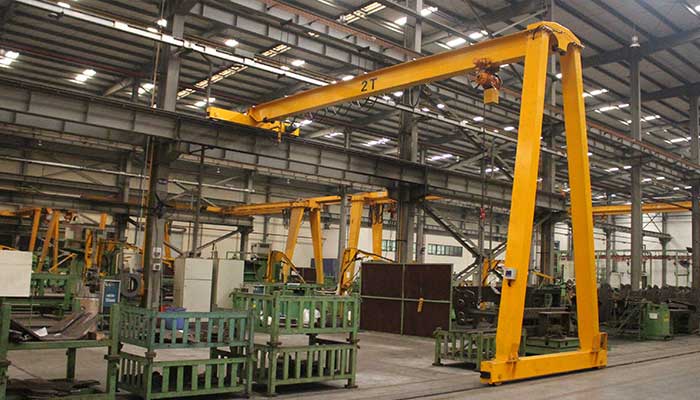
I-Beam Girder Semi-Gantry Crane:
I-beam girders are commonly used in semi-gantry cranes for lighter to moderate load applications. They are cost-effective and offer adequate strength for various material handling tasks.
Features:I-beam girder cranes are cost-effective and offer sufficient strength for moderate load handling. They are relatively lightweight compared to box girders.
Benefits:They are economical and versatile for a wide range of applications, making them a practical choice for many industries.
Typical Applications:Commonly found in manufacturing facilities, warehouses, and small-to-medium scale material handling operations.
In the following, let's check the comparison of the similarities and differences between box girder, truss girder, and I-beam girder semi-gantry cranes in both bullet form and a table:
Similarities:
- All three types are semi-gantry cranes, meaning they have one end supported by a vertical column or leg, and the other end runs on rails or wheels along the ground.
- They are used for material handling in various industrial applications.
- They can be customized to meet specific load capacity and span requirements.
- These cranes offer versatility in handling different types of loads and can be adapted to various application conditions.
Differences:
| Feature | Box Girder Semi-Gantry Crane | I-Beam Girder Semi-Gantry Crane |
|---|---|---|
| Girder Design | Box-shaped girder | I-shaped (I-beam) girder |
| Structural Stability | High | Moderate |
| Weight | Heavier | Moderate |
| Strength-to-Weight Ratio | Good | Moderate |
| Cost | Moderate to High | Low to Moderate |
| Precision | High | Moderate |
| Typical Applications | Heavy loads and precision | Cost-effective and versatile |
Box Girder Semi-Gantry Crane:
- Girder Design: Box-shaped girder for increased structural stability.
- Structural Stability: High structural stability and resistance to deflection.
- Weight: Heavier compared to truss and I-beam girders.
- Strength-to-Weight Ratio: Good.
- Cost: Moderate to high.
- Precision: High precision, suitable for heavy loads and precision applications.
- Typical Applications: Used for precision and heavy-duty applications, such as in aerospace and automotive manufacturing.
I-Beam Girder Semi-Gantry Crane:
- Girder Design: I-shaped (I-beam) girder for cost-effectiveness.
- Structural Stability: Moderate structural stability.
- Weight: Moderate.
- Strength-to-Weight Ratio: Moderate.
- Cost: Low to moderate.
- Precision: Moderate precision, suitable for cost-effective and versatile material handling.
- Typical Applications: Found in manufacturing facilities, warehouses, and small-to-medium scale material handling operations where cost-efficiency is a priority.

Single Girder Semi-Gantry Crane:
Features:Single girder semi-gantry cranes feature a single horizontal girder that offers a simple and lightweight design. This makes them cost-effective and suitable for lighter to moderate load handling.
Benefits:They are economical, easy to install, and provide efficient material handling for various applications. Single girder cranes are ideal for smaller workspaces.
Typical Applications:Commonly used in manufacturing facilities, warehouses, and workshops, where they handle materials efficiently in confined or limited-height spaces.
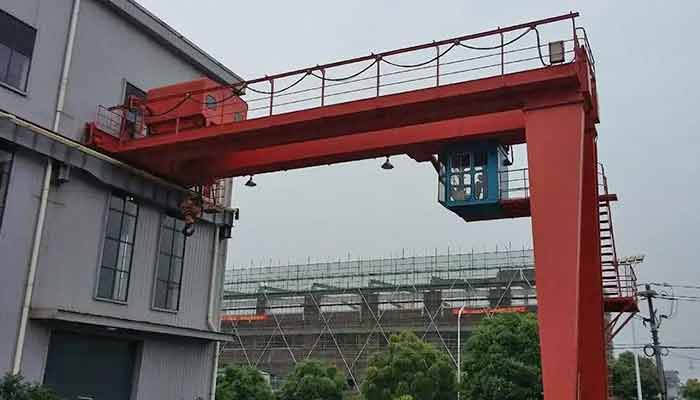
Double Girder Semi-Gantry Crane:
Features:Double girder semi-gantry cranes are supported by two horizontal girders, offering increased load-bearing capacity and stability. This design is robust and capable of handling heavier loads.
Benefits:They provide high load capacity, precise load control, and versatility for a wide range of heavy-duty applications. Double girder cranes are well-suited for industrial settings.
Typical Applications:Found in industries such as steel manufacturing, heavy machinery assembly, and other applications requiring the lifting of exceptionally heavy loads. They are used in larger workspaces with higher clearance.
In the following, let's check the comparison of the similarities and differences between single girder and double girder semi-gantry cranes in both bullet form and a table:
Similarities:
- Both single girder and double girder semi-gantry cranes are semi-gantry crane types, meaning they have one end supported by a vertical column or leg, and the other end runs on rails or wheels along the ground.
- They are used for material handling in various industrial applications.
- Both can be customized to meet specific load capacity and span requirements.
- These cranes offer versatility in handling different types of loads and can be adapted to various application conditions.
Differences:
| Feature | Single Girder Semi-Gantry Crane | Double Girder Semi-Gantry Crane |
|---|---|---|
| Girder Configuration | One horizontal girder | Two horizontal girders |
| Load Capacity | Typically lower | Typically higher |
| Vertical Clearance | Limited due to single girder | Greater vertical clearance due to double girders |
| Structural Complexity | Simpler design | More complex design |
| Installation Cost | Lower | Higher |
| Precision | Moderate | High |
| Typical Applications | Lighter to moderate loads, smaller workspaces | Heavier loads, larger workspaces, heavy manufacturing |
Single Girder Semi-Gantry Crane:
- Girder Configuration: Consists of one horizontal girder.
- Load Capacity: Typically suited for lighter to moderate loads.
- Vertical Clearance: Limited due to the single girder, making it ideal for spaces with lower ceilings.
- Structural Complexity: Simpler design.
- Installation Cost: Lower cost due to its simpler design.
- Precision: Moderate precision.
- Typical Applications: Used for lighter to moderate loads in smaller workspaces, workshops, and warehouses.
Double Girder Semi-Gantry Crane:
- Girder Configuration: Features two horizontal girders.
- Load Capacity: Typically designed to handle heavier loads.
- Vertical Clearance: Offers greater vertical clearance, making it suitable for larger workspaces with higher ceilings.
- Structural Complexity: More complex design due to the two girders.
- Installation Cost: Higher installation cost due to the additional girder and greater capacity.
- Precision: High precision, often used in applications requiring precision and stability.
- Typical Applications: Suitable for handling heavier loads in larger workspaces, industrial facilities, and heavy manufacturing.
Cantilever Design:
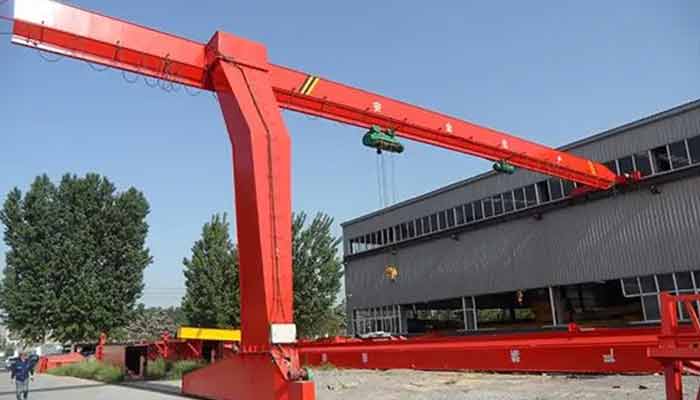
Fixed Cantilever Semi-Gantry Crane:
In this design, the cantilever arm remains fixed in its position. It is ideal for applications where the crane needs to reach a specific area or access materials along a fixed path.
Features:Fixed cantilever arms are rigid and remain stationary, providing a specific reach and coverage area.
Benefits:They are suitable for applications where materials or workstations are consistently located in a fixed position.
Typical Applications:Used in situations where loads follow a predictable path or are located in a set position, such as in certain manufacturing and assembly processes.

Adjustable Cantilever Semi-Gantry Crane:
These cranes have a cantilever arm that can be adjusted in terms of reach and height. They are suitable for tasks that require flexibility in the reach and lifting height.
Features:These cranes have cantilever arms that can be adjusted in terms of reach and height.
Benefits:They offer flexibility in adapting to different workspaces and varying load sizes or positions.
Typical Applications:Useful in environments where the location and height of loads are subject to change, such as maintenance shops, assembly lines, or versatile material handling operations.
In the following, let's check the comparison of the similarities and differences between fixed cantilever and adjustable cantilever semi-gantry cranes in both bullet form and a table:
Similarities:
- Both fixed and adjustable cantilever semi-gantry cranes are semi-gantry crane types, meaning they have one end supported by a vertical column or leg, and the other end runs on rails or wheels along the ground.
- They are designed for applications where the crane's reach is a critical factor.
- Both types of cranes can handle various load capacities, depending on the specific configuration and design.
Differences:
| Feature | Fixed Cantilever Semi-Gantry Crane | Adjustable Cantilever Semi-Gantry Crane |
|---|---|---|
| Cantilever Design | Fixed, remains stationary | Adjustable, capable of being modified in terms of reach and height |
| Reach Flexibility | Limited to the fixed cantilever length | Offers flexibility in adjusting the reach as needed |
| Precision | Suitable for applications with fixed workstations or predictable load positions | Suitable for applications with varying load positions or heights |
| Cost | May be less expensive due to the stationary design | May have higher cost due to the added adjustability features |
| Typical Applications | Suitable for applications where materials or workstations are consistently located in a fixed position | Ideal for applications where materials, workstations, or loads may vary in their location or height |
Fixed Cantilever Semi-Gantry Crane:
- Cantilever Design: Features a fixed cantilever arm that remains stationary.
- Reach Flexibility: Limited to the fixed cantilever length.
- Precision: Suited for applications with fixed workstations or predictable load positions.
- Cost: May be less expensive due to the stationary design.
- Typical Applications: Ideal for applications where materials or workstations are consistently located in a fixed position, making it suitable for tasks with predictable load positions.
Adjustable Cantilever Semi-Gantry Crane:
- Cantilever Design: Equipped with an adjustable cantilever arm that can be modified in terms of reach and height.
- Reach Flexibility: Offers flexibility in adjusting the reach as needed.
- Precision: Suitable for applications with varying load positions or heights.
- Cost: May have a higher cost due to the added adjustability features.
- Typical Applications: Ideal for applications where materials, workstations, or loads may vary in their location or height, making it suitable for tasks with changing load positions.
Hot Sale Tonages of Semi Gantry Cranes
The "hot sale" tonnages, crane designs, and configurations of semi-gantry cranes can vary depending on market demand, industry trends, and regional factors. However, I can provide some general insights into common tonnages, designs, and configurations that are often in demand:
5-ton Semi-Gantry Crane: This is a popular choice for light to moderate material handling in smaller manufacturing facilities and workshops.
10-ton Semi-Gantry Crane: A versatile option for various industries, including warehouses and medium-sized manufacturing operations.
20-ton Semi-Gantry Crane: Used for heavier loads, particularly in industries like steel fabrication and automotive manufacturing.
50-ton Semi-Gantry Crane: Commonly used in heavy industries such as steel mills, shipyards, and large-scale construction sites.
Custom Tonnages: Depending on specific industrial needs, custom tonnages may also be in high demand.
Application Environment:
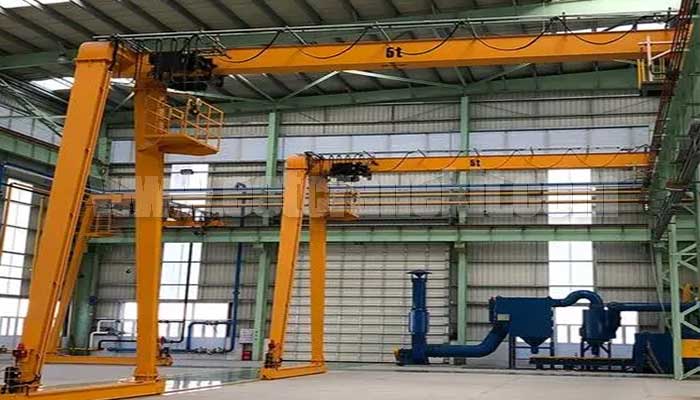
These cranes are designed for use in indoor environments, such as manufacturing facilities and warehouses. They are typically electrically powered and can be customized to meet specific workspace constraints.
Features:Indoor cranes are electrically powered and customizable to specific indoor workspace constraints.
Benefits:They provide precise control and efficiency in indoor manufacturing and warehousing environments.
Typical Applications:Manufacturing facilities, warehouses, and distribution centers.
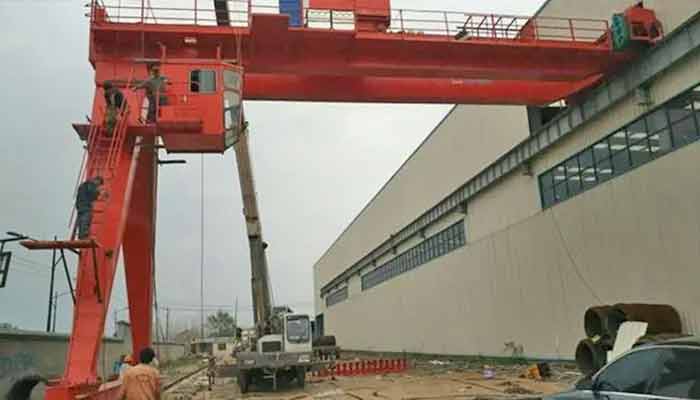
Outdoor semi-gantry cranes are designed to withstand exposure to the elements. They often have weather-resistant components and finishes to protect against corrosion.
Features:Designed to withstand outdoor conditions with weather-resistant components and finishes.
Benefits:Suitable for operations in open yards and ports, providing the strength and durability needed for outdoor applications.
Typical Applications:Ports, shipyards, and construction sites where exposure to the elements is common.
Here's a comparison of the similarities and differences between indoor and outdoor semi-gantry cranes in both bullet form and a table:
Similarities:
- Both indoor and outdoor semi-gantry cranes are types of semi-gantry cranes designed for material handling in various industrial applications.
- They share the fundamental structure of a semi-gantry crane, with one end supported by a vertical column or leg, and the other end running on rails or wheels along the ground.
- Both types can be customized to meet specific load capacity and span requirements.
- These cranes offer versatility in handling different types of loads and can be adapted to various application conditions.
Differences:
| Feature | Indoor Semi-Gantry Crane | Outdoor Semi-Gantry Crane |
|---|---|---|
| Application Environment | Designed for indoor settings, typically within controlled temperature and humidity conditions | Designed for outdoor environments, exposed to weather elements like rain, wind, and temperature fluctuations |
| Weather Resistance | Generally not weather-resistant, with standard components designed for indoor use | Equipped with weather-resistant components, finishes, and corrosion protection to withstand outdoor conditions |
| Mobility | Typically not designed for frequent relocation | Designed to be mobile and often used in outdoor yards where mobility is required |
| Structure and Design | Indoor cranes can have components that are not as resistant to corrosion | Outdoor cranes have components built to withstand corrosion from exposure to the elements |
| Control Systems | Indoor cranes may use standard electrical control systems | Outdoor cranes may require specialized control systems for weatherproofing and additional safety features |
| Typical Applications | Manufacturing facilities, warehouses, and controlled indoor environments | Ports, shipyards, construction sites, and other outdoor environments where exposure to the elements is common |
Indoor Semi-Gantry Crane:
- Application Environment: Designed for use in indoor settings with controlled temperature and humidity conditions.
- Weather Resistance: Generally not weather-resistant, with standard components designed for indoor use.
- Mobility: Typically not designed for frequent relocation.
- Structure and Design: Indoor cranes may have components that are not as resistant to corrosion.
- Control Systems: Use standard electrical control systems suitable for indoor use.
- Typical Applications: Found in manufacturing facilities, warehouses, and controlled indoor environments where exposure to the elements is not a concern.
Outdoor Semi-Gantry Crane:
- Application Environment: Designed for outdoor environments exposed to weather elements such as rain, wind, and temperature fluctuations.
- Weather Resistance: Equipped with weather-resistant components, finishes, and corrosion protection to withstand outdoor conditions.
- Mobility: Designed to be mobile and often used in outdoor yards where mobility is required.
- Structure and Design: Components are built to withstand corrosion from exposure to the elements.
- Control Systems: May require specialized control systems for weatherproofing and additional safety features.
- Typical Applications: Suitable for use in ports, shipyards, construction sites, and other outdoor environments where exposure to the elements is common.
Semi Gantry Crane Classification based on Application Conditions:
General-Purpose Semi-Gantry Crane:
These cranes are versatile and suitable for a wide range of applications. They are often used for tasks like material handling in manufacturing or warehousing.
Features:Versatile and capable of handling a wide range of loads and tasks.
Benefits:Offers adaptability and efficiency for various material handling applications.
Typical Applications:Found in general manufacturing, warehousing, and assembly processes.
Port and Shipping Yard Semi-Gantry Crane:
These cranes are designed for the specific needs of ports and shipping yards, where they are used to load and unload cargo from ships or move containers.
Port and Shipping Yard Semi-Gantry Crane:
Features:Engineered for heavy-duty cargo handling with specialized features like container spreaders.
Benefits:Can efficiently load and unload cargo from ships, including containers, bulk goods, and oversized items.
Typical Applications:Ports, container terminals, and shipping yards.
Construction Site Semi-Gantry Crane:
Semi-gantry cranes in construction sites are built to handle heavy construction materials and equipment. They are often portable and used in various construction phases.
Features:Often portable, robust, and designed to handle construction materials and equipment.
Benefits:Mobility and strength for use in various construction phases.
Typical Applications:Construction sites for building and infrastructure projects.
Heavy-Duty Semi-Gantry Crane:
These cranes are designed to handle extremely heavy loads. They are often used in industries like steel manufacturing and large-scale machinery assembly.
Features:Engineered for extreme loads and designed with reinforced structures and components.
Benefits:Capable of handling heavy machinery, large industrial components, and steel materials.
Typical Applications:Heavy manufacturing, steel mills, and industries with oversized or exceptionally heavy loads.
Light-Duty Semi-Gantry Crane:
Light-duty semi-gantry cranes are used for smaller loads and more delicate handling tasks, such as in smaller workshops or production lines.
Features:Suitable for lighter loads and more delicate handling.
Benefits:Provides cost-effective solutions for smaller workshops and production lines with less demanding loads.
Typical Applications:Small manufacturing operations, workshops, and facilities with less substantial materials.
Optional features for different industrial sectors and application conditions
What are the option features for semi gantry cranes which are used for different industrial sectors and application conditions ?
Semi-gantry cranes can be equipped with a range of optional features to enhance their performance, safety, and suitability for different industrial sectors and application conditions. These options can be customized based on specific needs. Here are some common optional features for semi-gantry cranes:
- Variable Speed Controls:Variable speed controls for trolley and hoist motions allow for precise load positioning and improved productivity. Different industrial sectors may require varying speed capabilities.
- Radio Remote Control:Remote control systems enable operators to control the crane from a safe distance, enhancing safety and visibility, especially in industries where precise load placement is critical.
- Load Weighing Systems:Load weighing systems provide real-time data on the weight of the load being lifted, which is crucial for industries like shipping, where weight restrictions and precision are essential.
- Environmental Protection:Industries operating in harsh environments, such as ports and steel mills, benefit from weatherproof and corrosion-resistant features to protect the crane from environmental factors.
- Dust and Spark Resistance:For sectors like woodworking or chemical manufacturing, cranes may be equipped with features to reduce the risk of sparks and dust ignition, enhancing safety.
- Explosion-Proof Components:Industries like oil and gas may require explosion-proof components to prevent ignition sources in potentially explosive atmospheres.
- Wireless Communication:Wireless communication systems improve data transfer between the crane and operators, essential for industries that rely on real-time data, such as logistics and shipping.
- Infrared Sensors:Infrared sensors can be used to detect obstacles in the crane's path, enhancing safety and avoiding collisions.
- Specialized Hooks and Attachments:Different industries may require specialized hooks, attachments, or lifting devices to handle specific types of loads, such as containers, coils, or machinery.
- Automatic Positioning Systems:Automation features, like automatic load positioning systems, are valuable for industries that require repetitive tasks, such as assembly lines.
- Advanced Safety Systems:Additional safety features, like anti-collision systems, emergency stop buttons, and overload protection, are vital for industries with strict safety standards.
- Customizable Controls:User-friendly and customizable control panels to adapt the crane's operation to the specific requirements of the industry or application.
- Adjustable Height Features:Adjustable height capabilities are useful for industries where the lifting height of loads varies.
- Quick-Change Attachments:Industries with frequent changes in load types may benefit from quick-change attachment systems to optimize efficiency.
- 1Energy-Efficient Components:Energy-efficient motors and components can help reduce operational costs and environmental impact, which is important for sustainable industries.
- 1 Telemetry and Remote Monitoring:Remote monitoring and telemetry systems enable remote diagnostics, maintenance, and performance analysis, ideal for industries with multiple crane systems.
- 1 Load Sway Control:Load sway control systems minimize the swinging of the load during lifting and transfer, improving safety and precision, especially in sectors like steel manufacturing.
- 1Load Sensors:Load sensors provide data on the weight and balance of the load, contributing to safe and efficient lifting.
- 1Emergency Backup Systems:Backup power and control systems are crucial for industries where power interruptions could lead to significant disruptions.
- 20. Custom Paint and Finishes:Customizable paint colors and finishes can be matched to the industry's branding or environmental requirements.
The choice of optional features for a semi-gantry crane depends on the specific needs and conditions of the industrial sector and the application. These features can significantly enhance the crane's functionality and safety while optimizing its performance for a particular industry or application.
Advantages of Semi Gantry Cranes
Semi gantry cranes are more than just unique in design; they bring a host of advantages to material handling scenarios. In this section, we'll explore the versatility of semi gantry cranes, discover where they shine in real-world applications, and understand how they harmoniously combine precision and adaptability to create a winning combination.
The Versatility of Semi Gantry Cranes
Semi gantry cranes are revered for their versatility, making them adaptable to a wide range of industries and tasks. Their advantages include:
- Workspace Optimization:In industries where floor space is limited, semi gantry cranes shine. They can be positioned close to walls or columns, effectively utilizing available space while accommodating the precise movement of materials.
- Ease of Relocation:Unlike fixed equipment, semi gantry cranes offer the flexibility of relocation. Need to reconfigure your workspace? No problem. Semi gantry cranes can be easily moved to a new location to accommodate evolving operational needs.
- Modular Design:Many semi gantry cranes boast a modular design, allowing for customization with various accessories and add-ons. This adaptability ensures that the crane can be tailored to your specific material handling requirements.
Applications: Where Semi Gantry Cranes Shine
Semi gantry cranes prove their worth in a multitude of industries and scenarios. Some real-world applications include:
- Manufacturing and Assembly:In manufacturing facilities, precision and efficiency are paramount. Semi gantry cranes excel at precisely positioning heavy components on assembly lines, streamlining production processes.
- Warehousing and Storage:Warehouses often grapple with limited floor space. Semi gantry cranes provide the precision needed to place goods on high shelves or racks efficiently, maximizing vertical storage.
- Construction:On construction sites, semi gantry cranes are indispensable for lifting and positioning construction materials and equipment. Their adaptability ensures they can work around evolving project layouts.
- Maintenance and Repair:Industries that involve equipment maintenance benefit from the precision of semi gantry cranes when handling machinery components for repairs, minimizing downtime and ensuring safety.
Precision Meets Adaptability: A Winning Combination
Perhaps the most compelling advantage of semi gantry cranes is their ability to seamlessly marry precision and adaptability. This unique combination allows them to excel in applications that demand meticulous load positioning while maintaining the flexibility to adapt to ever-changing operational requirements.
In the next section, we'll guide you through the process of determining your material handling needs and how semi gantry cranes can be tailored to meet those requirements.
What are the typical applications of semi gantry cranes ?
Semi-gantry cranes are versatile material handling solutions used in various industries and applications. Here are more detailed applications where semi-gantry cranes are commonly used:
Here's an overview of how semi-gantry cranes are used in various conditions, along with typical design features, capacity, and loads handled and typical below the hook devices used :
Manufacturing Facilities:
Semi-gantry cranes are used to move materials and components along assembly lines in manufacturing plants, facilitating efficient production processes.
They are employed to lift and position heavy machinery or equipment during manufacturing and assembly operations.
Typical Semi-Gantry Design and Capacity: Single or double girder design with capacities ranging from 1 ton to 20 tons.
Typical Loads or Objects Handled in Manufacturing Facilities: Machine parts, tools, molds, heavy equipment, and materials used in the production process.
Typical Below-the-Hook Devices: Hooks, slings, lifting beams, and customized lifting fixtures for various components.
Warehouses and Distribution Centers:
Semi-gantry cranes are utilized for loading and unloading trucks, handling palletized goods, and optimizing storage space.
They facilitate the movement of goods within the warehouse, improving logistics and inventory management.
Typical Semi-Gantry Design and Capacity: Single girder design with capacities ranging from 2 tons to 10 tons.
Typical Loads or Objects Handled in Warehouses: Pallets, containers, cartons, and various goods for storage and distribution.
Typical Below-the-Hook Devices: Spreader bars, hooks, and specialized lifting attachments for palletized loads.
Loading Docks:
Semi-gantry cranes are used at loading docks in distribution centers, factories, and logistics hubs to transfer goods between trucks and storage areas.
They enhance efficiency and safety during loading and unloading operations.
Typical Semi-Gantry Design and Capacity: Single or double girder design with capacities ranging from 3 tons to 20 tons.
Typical Loads or Objects Handled at Loading Docks: Palletized goods, crates, machinery, and cargo from trucks.
Typical Below-the-Hook Devices: J-hooks, C-hooks, and lifting attachments for handling various cargo types.
Construction Sites:
Portable semi-gantry cranes are common at construction sites for lifting and positioning heavy materials such as steel beams, concrete blocks, and equipment.
They assist in building structures and moving materials to various work areas.
Typical Semi-Gantry Design and Capacity: Single girder design with capacities ranging from 2 tons to 10 tons.
Typical Loads or Objects Handled at Construction Sites: Steel beams, concrete blocks, construction materials, and heavy equipment.
Typical Below-the-Hook Devices: Concrete buckets, clamshell buckets, and custom lifting attachments for construction materials.
Steel Mills and Metal Fabrication:
Semi-gantry cranes handle the movement of raw materials, finished products, and equipment in steel mills and metal fabrication facilities.
They are essential for the transportation of heavy steel coils, bars, and sheets.
Typical Semi-Gantry Design and Capacity: Single or double girder design with capacities ranging from 5 tons to 50 tons.
Typical Loads or Objects Handled in Steel Mills: Steel coils, ingots, metal sheets, and heavy machinery.
Typical Below-the-Hook Devices: Coil hooks, C-hooks, and lifting magnets for steel products.
Aerospace Industry:
In the aerospace industry, semi-gantry cranes assist in positioning aircraft components, engines, and sensitive equipment with precision.
They are designed to meet strict safety and precision requirements.
Typical Semi-Gantry Design and Capacity: Customized designs with capacities tailored to the specific aerospace needs.
Typical Loads or Objects Handled in Aerospace: Aircraft components, engines, delicate aerospace equipment, and precision tools.
Typical Below-the-Hook Devices: Precision fixtures, vacuum lifters, and specialized tooling for aerospace components.
Shipbuilding and Ports:
Semi-gantry cranes are employed in shipyards for lifting and assembling ship components, including hull sections and containers.
At ports, they handle cargo containers, loading and unloading ships efficiently.
Typical Semi-Gantry Design and Capacity: Customized designs with high load capacities, ranging from 10 tons to 100 tons.
Typical Loads or Objects Handled in Shipbuilding and Ports: Ship components, containers, and bulk cargo.
Typical Below-the-Hook Devices: Spreader beams, container lifting frames, and specialized attachments for ship components.
Automotive Manufacturing:
Semi-gantry cranes are used for lifting and positioning heavy automotive components, including engines, bodywork, and vehicle parts.
They play a critical role in the assembly and manufacturing of vehicles.
Typical Semi-Gantry Design and Capacity: Single or double girder design with capacities ranging from 5 tons to 30 tons.
Typical Loads or Objects Handled in Automotive Manufacturing: Vehicle components, engines, car bodies, and machinery.
Typical Below-the-Hook Devices: Engine slings, bodywork fixtures, and customized lifting attachments for automotive components.
Woodworking and Sawmills:
In woodworking and sawmill operations, semi-gantry cranes handle large timber logs, boards, and lumber.
They
assist in sorting, stacking, and transporting wood products.
Typical Semi-Gantry Design and Capacity: Single girder design with capacities ranging from 2 tons to 10 tons.
Typical Loads or Objects Handled in Woodworking: Timber logs, lumber, wood panels, and processed wood products.
Typical Below-the-Hook Devices: Lumber hooks, log tongs, and specialized attachments for wood products.
Mining and Quarrying:
Semi-gantry cranes are employed in mining and quarrying for material handling and the extraction of minerals, rocks, and ores.
They facilitate the transportation of heavy materials within the mining site.
Typical Semi-Gantry Design and Capacity: Customized designs with high load capacities, ranging from 10 tons to 100 tons.
Typical Loads or Objects Handled in Mining and Quarrying: Raw minerals, rocks, ore, and heavy machinery.
Typical Below-the-Hook Devices: Heavy-duty lifting hooks, grapples, and specialized lifting gear for minerals and rocks.
Utilities and Power Plants:
In power generation facilities, semi-gantry cranes handle equipment and components such as turbines, generators, and maintenance tools.
They play a vital role in plant operations, maintenance, and construction.
Typical Semi-Gantry Design and Capacity: Customized designs with capacities tailored to the specific utility or power plant requirements.
Typical Loads or Objects Handled in Utilities: Turbines, generators, heavy power equipment, and maintenance tools.
Typical Below-the-Hook Devices: Custom lifting fixtures, turbine lifters, and specialized tooling for power plant equipment.
Food and Beverage Industry:
Semi-gantry cranes are used for handling bulk containers, ingredients, and finished products in food processing and bottling plants.
They facilitate the movement of products through various stages of production.
Typical Semi-Gantry Design and Capacity: Single girder design with capacities ranging from 2 tons to 10 tons.
Typical Loads or Objects Handled in the Food and Beverage Industry: Bulk ingredients, product containers, and finished goods.
Typical Below-the-Hook Devices: Custom food-grade attachments, container lifters, and specialized lifting gear for food processing.
Waste Management:
Semi-gantry cranes are utilized in recycling and waste management facilities for lifting and sorting recyclable materials.
They help load materials onto conveyors and transport them within the facility.
Typical Semi-Gantry Design and Capacity: Single girder design with capacities ranging from 2 tons to 10 tons.
Typical Loads or Objects Handled in Waste Management: Recyclable materials, waste bins, and materials on conveyors for processing.
Typical Below-the-Hook Devices: Grapples, magnets, and custom attachments for handling waste materials.
Entertainment and Event Industry:
In event and entertainment venues, semi-gantry cranes are used for stage setups, lighting, and sound equipment.
They play a role in creating dynamic stage productions and ensuring safety during events.
Typical Semi-Gantry Design and Capacity: Customized designs to meet the specific needs of the entertainment industry.
Typical Loads or Objects Handled in Entertainment: Stage equipment, lighting fixtures, audiovisual components, and props for events and performances.
Typical Below-the-Hook Devices: Stage rigging systems, lighting trusses, and specialized attachments for event equipment.
These are just some of the many diverse applications of semi-gantry cranes in various industries and settings. Semi-gantry cranes are adaptable, reliable, and capable of handling a wide range of loads, making them valuable tools in material handling and lifting operations across different sectors. Their design and capacity can be customized to match the specific needs of each application.
Determining Your Material Handling Needs
To harness the full potential of a semi gantry crane, it's essential to start by analyzing your unique material handling requirements. In this section, we'll guide you through this crucial process, helping you determine the load capacity, span, lift height, and load distribution considerations that will shape your choice of semi gantry crane.
Analyzing Your Unique Requirements
Every industry and operational environment is unique, and your material handling needs are no exception. Start by considering:
- Work Environment:What is the nature of your workspace? Are there spatial constraints, obstacles, or specific layouts that need to be accommodated?
- Operational Demands:What types of materials or products will you be handling? Are they heavy, bulky, or delicate? Understanding the nature of your loads is critical.
- Workflow:How does material flow through your workspace? Identifying the points where lifting and positioning are required is essential for crane placement.
- Frequency of Use:Do you need continuous, intermittent, or occasional lifting? The frequency of use can impact the type of crane that best suits your needs.
Load Capacity: Finding the Perfect Fit
One of the primary considerations when choosing a semi gantry crane is load capacity. To determine the right fit:
- Evaluate Load Weight:Calculate the maximum weight of the loads you'll be handling. Ensure you account for potential growth in load sizes over time.
- Consider Load Dynamics:Understand how loads will be moved. Are they static, or do they require precise positioning? This can affect crane selection.
- Factor in Safety Margins:It's prudent to build in a safety margin when determining load capacity to ensure that the crane operates safely and efficiently.
Span, Lift Height, and Load Distribution Considerations
Beyond load capacity, other factors play a pivotal role in determining your material handling needs:
- Span:Measure the distance between the crane's support points. This determines the crane's coverage area. Ensure it matches the spatial requirements of your workspace.
- Lift Height:Consider the vertical distance the crane needs to lift loads. This involves not only the initial lift height but also any future expansion or changes in your operational needs.
- Load Distribution:Understanding how the load weight is distributed can impact crane stability and performance. Ensure that the crane's load distribution capabilities align with your requirements.
By analyzing these critical factors, you'll be well-equipped to choose a semi gantry crane that perfectly aligns with your material handling needs. In the next section, we'll explore installation and configuration options, ensuring that your crane seamlessly integrates into your workspace.
Installation and Configuration Options
Once you've determined your material handling needs and the right load capacity for your operations, it's time to delve into the practical aspects of installing and configuring your semi gantry crane. In this section, we'll provide essential insights into the installation process, help you decide between wall-mounted and floor-mounted variants, and explore how semi gantry cranes can optimize vertical space in warehousing environments.
Installing Semi Gantry Cranes: What You Need to Know
Installing a semi gantry crane involves a series of steps to ensure safe and efficient operation:
- Foundation Requirements:Start by assessing the foundation where the grounded leg of the crane will be placed. It should be capable of bearing the crane's weight and loads.
- Structural Considerations:Evaluate the structural integrity of the existing support structure on the other side of the crane. Ensure it can withstand the crane's forces and load distribution.
- Positioning:Determine the ideal placement of the crane within your workspace to maximize efficiency and safety. Consider the workflow and proximity to load points.
- Rail Installation:Semi gantry cranes typically run on a rail system for horizontal movement. Proper installation of the rail is essential for smooth crane operation.
Choosing Between Wall-Mounted and Floor-Mounted Variants
Wall-mounted gantry cranes and floor-mounted gantry cranes are two different types of gantry cranes used in various material handling applications. They differ in their mounting configurations and usage. Here's an overview of each type:
- Wall-Mounted Semi Gantry Crane :In this configuration, one side of the crane is anchored to a wall or other vertical support structure. Wall-mounted semi gantry cranes are space-efficient and ideal for operations with limited floor space.
- Floor-Mounted Full Gantry Crane:Floor-mounted Full gantry cranes have both legs grounded on the floor. This configuration provides greater stability and load capacity but may require more floor space.

Mounting Configuration:A wall-mounted gantry crane is fixed to the wall or structure of a building. It does not have supporting legs on the floor, relying on the structural integrity of the building to support the crane.
Usage:Wall-mounted gantry cranes are commonly used in situations where there is limited floor space or a need to keep the floor area clear for other activities. They are suitable for applications where loads need to be lifted, moved, and positioned within a specific area near a wall.
Typical Applications:These cranes are used in workshops, manufacturing facilities, maintenance shops, and other industrial settings where wall support is available. They are ideal for tasks like moving heavy machinery, engines, or materials along a wall or specific workstations.
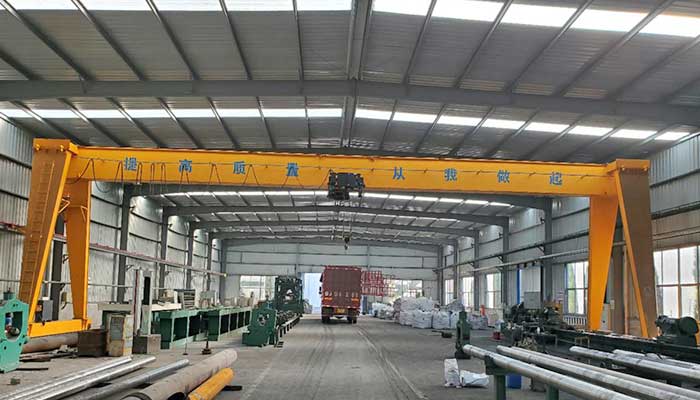
Mounting Configuration:A floor-mounted gantry crane is supported by legs that rest directly on the floor. They are self-supporting structures and do not rely on the building's walls for support.
Usage:Floor-mounted gantry cranes are versatile and can be placed anywhere on a level floor. They are often used when there is a need for mobility and flexibility in positioning the crane throughout the workspace.
Typical Applications:These cranes are used in a wide range of industrial settings, including manufacturing facilities, warehouses, loading docks, construction sites, and more. They are suitable for lifting and moving heavy loads across a spacious work area.
In the following, let's check the comparison of the similarities and differences between wall-mounted semi-gantry cranes and floor-mounted full gantry cranes in a table format:
| Feature | Wall-Mounted Semi-Gantry Crane | Floor-Mounted Full Gantry Crane |
|---|---|---|
| Mounting Configuration | Attached to the building's wall | Supported by legs on the floor |
| Support Structure | Partially relies on the building's structure for support | Self-supporting structure with legs resting on the floor |
| Mobility and Positioning | Stationary; limited mobility | Mobile and can be positioned anywhere on a level floor |
| Space Utilization | Efficient use of wall space | Suitable for larger open areas |
| Flexibility | Limited to work along the wall | Highly flexible and versatile in terms of positioning |
| Installation and Relocation | Typically fixed; not easily relocated | Can be relocated to different locations as needed |
| Load Capacity and Versatility | Suitable for light to moderate loads; limited versatility | Ideal for a wide range of load capacities and versatile material handling |
| Typical Applications | Workshops, manufacturing facilities with limited floor space | Warehouses, manufacturing plants, construction sites, loading docks, and other industrial settings with ample floor space |
Key Differences:
- Mounting Configuration: Wall-mounted semi-gantry cranes are attached to the building's wall, while floor-mounted full gantry cranes are self-supporting structures with legs resting on the floor.
- Support Structure: Wall-mounted cranes partially rely on the building's structure for support, whereas floor-mounted gantry cranes are self-supporting.
- Mobility and Positioning: Wall-mounted cranes are stationary and limited to working along the wall, while floor-mounted gantry cranes are mobile and can be positioned anywhere on a level floor.
- Space Utilization: Wall-mounted cranes efficiently use wall space in situations with limited floor space, while floor-mounted gantry cranes are suitable for larger open areas.
- Installation and Relocation: Wall-mounted cranes are typically fixed and not easily relocated, while floor-mounted gantry cranes can be relocated to different locations as needed.
- Load Capacity and Versatility: Wall-mounted cranes are suitable for light to moderate loads with limited versatility, while floor-mounted gantry cranes can handle a wide range of load capacities and offer versatile material handling.
The choice between a wall-mounted semi-gantry crane and a floor-mounted full gantry crane depends on factors such as available space, load capacity requirements, mobility needs, and the specific application environment. Each type serves different material handling needs and is selected based on the demands of the task at hand.
Your choice between wall-mounted and floor-mounted variants should align with your workspace layout, load requirements, and available structural support.
Maximizing Vertical Space: Semi Gantry Cranes and Warehousing
Warehouses often grapple with the challenge of efficiently utilizing vertical storage space. Semi gantry cranes offer a solution:
- High Shelves and Racks:Semi gantry cranes can precisely place goods on high shelves and racks, making them invaluable for vertical storage optimization.
- Adaptable Placement:Their adaptability allows them to work around storage configurations, reaching otherwise challenging locations.
- Efficient Material Retrieval:Semi gantry cranes expedite the retrieval of goods from vertical storage, reducing retrieval times and improving warehouse efficiency.
By strategically placing semi gantry cranes in warehousing environments, you can make the most of your vertical space, streamlining inventory management and material handling processes.
As we move forward, safety becomes a paramount concern when operating semi gantry cranes. In the next section, we'll explore safety features and considerations to ensure secure crane operations in your workspace.
Safety First: Ensuring Secure Operations
The safe operation of semi gantry cranes is a top priority. In this section, we'll explore the critical safety features and considerations that should be at the forefront of your semi gantry crane setup. We'll also emphasize the importance of compliance with industry standards and outline the essential aspects of operator training and safety protocols.
Safety Features and Considerations
Safety features are an integral part of semi gantry crane design, ensuring secure operations. Key safety considerations include:
- Emergency Stop:Semi gantry cranes are equipped with emergency stop buttons that instantly halt crane movement in case of an emergency or when a safety hazard is detected.
- Overload Protection:Overload sensors and safeguards prevent the crane from lifting loads beyond its rated capacity, avoiding accidents and equipment damage.
- Limit Switches:Limit switches define the upper and lower travel limits of the crane, preventing it from inadvertently colliding with obstacles or exceeding safe travel distances.
- Collision Detection:Advanced semi gantry cranes may incorporate collision detection systems that can identify obstacles in the crane's path and trigger immediate stops.
- Load Control:Precise load control mechanisms ensure that loads are positioned accurately, reducing the risk of accidents during material handling.
Compliance with Industry Standards
Adherence to industry standards is paramount for crane safety. Ensure that your semi gantry crane meets or exceeds the relevant safety standards and regulations in your region. These standards typically cover aspects such as structural integrity, electrical systems, and operator training.
Operator Training and Safety Protocols
Well-trained operators are essential for safe crane operations. Operator training should include:
- Crane Familiarity:Operators should have a comprehensive understanding of the crane's controls, features, and safety mechanisms.
- Load Handling Techniques:Proper techniques for attaching, lifting, and positioning loads must be taught to operators.
- Safety Protocols:Operators should be well-versed in safety protocols, emergency procedures, and how to respond to potential hazards.
- Maintenance Awareness:Operators should have a basic understanding of crane maintenance, such as recognizing signs of wear or damage.
- Certification:Consider certifying operators to ensure that they have the knowledge and skills necessary for safe crane operation.
- Regular Refresher Training:Periodic training updates and refresher courses should be part of ongoing safety efforts to keep operators up-to-date on best practices.
Safety is a shared responsibility. Encourage a culture of safety within your organization, where all personnel are aware of and committed to adhering to safety protocols. Regular inspections and maintenance are essential to ensure that safety features remain in optimal working condition.
In the next section, we'll explore customization options and accessories that can further enhance the efficiency and safety of your semi gantry crane setup.
Customization and Accessories
To make your semi gantry crane truly work for your specific material handling needs, customization and the addition of appropriate accessories play a crucial role. In this section, we'll delve into the possibilities of tailoring your semi gantry crane, explore accessories that enhance efficiency and precision, and introduce modern customization options, from load monitoring to remote controls.
Tailoring Your Semi Gantry Crane to Specific Needs
One of the standout features of semi gantry cranes is their adaptability, which extends to customization. Consider the following ways you can tailor your crane to your specific requirements:
- Modular Design:Many semi gantry cranes offer a modular design, allowing for the integration of various components, such as hoists, trolleys, and specialized attachments.
- Height Adjustment:Adjustable height options can be incorporated to adapt to different load sizes and vertical space constraints.
- Variable Speed Controls:Customizing the speed at which your crane operates can optimize material handling for various loads and tasks.
- Specialized Attachments:Depending on your industry, you may require specialized attachments for lifting unique loads. These can be customized to fit your crane.
Accessories that Enhance Efficiency and Precision
Accessories play a vital role in enhancing the efficiency and precision of your semi gantry crane:
- Wireless Remote Controls:Wireless remote control systems allow operators to manage crane movements from a safe distance, improving visibility and precision during load handling.
- Load Monitoring Systems:Load monitoring systems provide real-time data on load weight and balance, helping operators make informed decisions for safe and efficient lifting.
- Positioning Sensors:Sensors that accurately measure and display the position of the crane and the load can significantly enhance precision.
- Anti-Sway Systems:These systems automatically counteract load sway during lifting and positioning, ensuring stability and safety.
- Load Rotation Devices:For industries that require load rotation, specialized devices can be added to your crane setup for seamless load manipulation.
- Weather Protection:When operating semi gantry cranes outdoors or in harsh environments, weather protection accessories, such as enclosures or covers, can safeguard equipment and extend its lifespan.
From Load Monitoring to Remote Controls: Modern Customization Options
Modern semi gantry cranes come with advanced customization options that can be tailored to your specific needs. These options include:
- Digital Controls:Digital control systems offer precise control over crane movements, making it easier to position loads accurately.
- Automated Functions:Some cranes can be programmed to perform repetitive tasks with minimal operator input, further enhancing efficiency.
- Telemetry and Data Logging:Collecting data on crane performance can aid in maintenance and performance optimization.
Customization and accessory selection should align with your unique operational requirements, industry demands, and safety considerations. In the following section, we'll explore real-world applications where semi gantry cranes prove their value.
Maintenance Best Practices
Maintaining the longevity and reliability of your semi gantry crane is paramount to its safe and efficient operation. In this section, we'll explore essential maintenance best practices, from routine inspections to lubrication, spare parts management, and the importance of operator training.
Ensuring the Longevity of Your Semi Gantry Crane
Proper maintenance is the key to ensuring that your semi gantry crane operates smoothly throughout its lifespan. By following best practices, you can extend the longevity of your equipment, reduce downtime, and enhance safety.
Routine Inspections: Catching Issues Early
Routine inspections are fundamental to crane maintenance. Inspections should include:
- Visual Inspections:Regularly visually inspect the crane for signs of wear, damage, or loose components. Pay attention to the crane's structure, electrical components, and safety features.
- Functional Tests:Perform functional tests to ensure that all crane operations, including hoisting, trolley movement, and bridge travel, are working correctly.
- Load Tests:Periodically conduct load tests to verify that the crane can handle its rated capacity safely.
- Safety System Checks:Test and verify that all safety features, such as emergency stop buttons and limit switches, are functioning as intended.
- Lubrication Checks:Check the crane's lubrication points to ensure that they are adequately lubricated to prevent excessive wear.
- Documentation:Maintain detailed records of inspections, repairs, and maintenance activities. This documentation can be invaluable for tracking the crane's performance and identifying trends.
Lubrication, Spare Parts, and Operator Training
- Lubrication:Proper lubrication is crucial to prevent friction and wear in moving parts. Follow the manufacturer's recommendations for lubrication schedules and use the correct lubricants.
- Spare Parts Management:Keep an inventory of essential spare parts to minimize downtime in case of component failure. Ensure that spare parts are genuine and compatible with your crane model.
- Operator Training:Well-trained operators are more likely to use the crane correctly and identify early signs of issues. Offer ongoing training to keep operators up-to-date on best practices and safety protocols.
- Scheduled Maintenance:Establish a regular maintenance schedule based on the crane's usage and environmental conditions. Consider scheduling annual or bi-annual comprehensive inspections by qualified technicians.
Remember that crane maintenance is a multifaceted effort that involves both proactive and reactive measures. While routine inspections and preventive maintenance are essential for catching issues early, it's equally important to respond promptly to any identified problems and implement corrective actions.
Supplier Selection and Manufacturer Reputation
Selecting the right supplier and manufacturer is a critical step in ensuring the quality, reliability, and support for your semi gantry crane. In this section, we'll guide you through the process of researching and identifying reputable manufacturers, evaluating supplier reputation and service, and emphasizing the importance of making an informed decision.
Researching and Identifying Reputable Manufacturers
Identifying reputable manufacturers of semi gantry cranes is the foundation of a successful procurement process. Here are steps to help you research and select the right manufacturer:
- Industry Expertise:Look for manufacturers with a proven track record in the design and production of semi gantry cranes. Their experience in the industry can be a strong indicator of reliability.
- Product Range:Consider manufacturers that offer a diverse range of crane models and customization options to ensure that you find a crane that meets your specific needs.
- Certifications and Compliance:Verify that the manufacturer complies with industry standards and regulations. Certifications such as ISO 9001 and CE are indicative of quality and safety adherence.
- Customer References:Seek customer references and reviews to gain insights into the manufacturer's reputation and the performance of their cranes in real-world applications.
- Local Presence:A manufacturer with a local presence or a strong network of dealers can provide faster support, spare parts availability, and maintenance services.
Evaluating Supplier Reputation and Service
While the manufacturer is pivotal, the supplier you choose to work with is equally important. Here's how to evaluate supplier reputation and service:
- Customer Support:Assess the supplier's customer support capabilities. Do they offer pre-sales consultation, installation assistance, and post-sales support? Prompt and effective support is invaluable.
- Service Agreements:Review the supplier's service agreements and warranty policies. Ensure that they provide comprehensive coverage and clear terms and conditions.
- References and Testimonials:Request references or testimonials from previous clients who have procured semi gantry cranes through the supplier. Their feedback can provide valuable insights into the supplier's reliability.
- Delivery and Lead Times:Evaluate the supplier's ability to meet your delivery timelines. Delays in crane delivery can disrupt your operational plans.
- Financial Stability:Consider the financial stability of the supplier to ensure that they can fulfill their contractual obligations and provide ongoing support.
Making an Informed Decision: The Importance of Supplier Selection
Selecting a reputable manufacturer and supplier is not only about the product itself but also about the long-term partnership and support they offer. Making an informed decision involves a comprehensive assessment of both the manufacturer and the supplier.
A well-established and reputable supplier will not only provide you with a high-quality semi gantry crane but also offer ongoing assistance, maintenance services, and spare parts availability. This ensures the smooth and reliable operation of your crane throughout its lifecycle.
Budgeting and Cost Analysis
When investing in a semi gantry crane, it's crucial to consider not only the initial purchase price but also the ongoing costs and the overall value it brings to your operations. In this section, we'll explore the various financial aspects of procuring and owning a semi gantry crane, including budgeting for ongoing costs, evaluating the Total Cost of Ownership (TCO), and making a wise investment that balances your budget with long-term value.
Beyond the Purchase Price: Budgeting for Ongoing Costs
While the purchase price is a significant component of your crane investment, it's just the tip of the financial iceberg. Consider these ongoing costs:
- Installation:Factor in the costs associated with crane installation, including any necessary modifications to your facility or infrastructure.
- Operating Costs:Calculate the expenses related to crane operation, such as electricity, maintenance, and operator salaries.
- Maintenance and Repairs:Budget for routine maintenance, inspections, and potential repairs to keep your crane in optimal working condition.
- Spare Parts:Maintain an inventory of essential spare parts to minimize downtime in case of component failure.
- Operator Training:Invest in ongoing operator training to ensure safe and efficient crane operation.
- Insurance:Include insurance costs for your crane to protect against unforeseen events and accidents.
Total Cost of Ownership (TCO) Evaluation
Evaluating the TCO of your semi gantry crane provides a comprehensive view of the financial impact over its entire lifecycle. Consider these factors:
- Purchase Price:Start with the initial purchase price of the crane, including any customization and accessories.
- Installation and Setup:Add the costs associated with installation, including any structural modifications or electrical work.
- Operating Costs:Estimate the annual operating costs, including electricity, maintenance, and operator expenses, over the crane's expected lifespan.
- Maintenance and Repairs:Include projected expenses for routine maintenance and potential repairs.
- Spare Parts:Account for the cost of spare parts over the crane's lifetime.
- Operator Training:Factor in the expenses for initial and ongoing operator training.
- Insurance:Calculate insurance premiums over the crane's operational years.
- Resale Value:Consider the potential resale value of the crane at the end of its service life.
Evaluating the TCO allows you to make a more informed financial decision by considering the long-term impact of your crane investment.
Investing Wisely: Balancing Budget and Long-Term Value
While budget constraints are important, it's essential to strike a balance between your budget and the long-term value that the semi gantry crane brings to your operations. Consider the following strategies:
- Prioritize Safety:Investing in safety features and training may increase initial costs but can significantly reduce the risk of accidents and costly downtime.
- Evaluate ROI:Calculate the potential return on investment (ROI) by assessing how the crane's efficiency and capabilities contribute to increased productivity and revenue.
- Consider Future Needs:Think about how your operational needs may evolve over time. Investing in a crane with flexibility and customization options can future-proof your investment.
- Explore Financing Options:Investigate financing options, such as leasing or financing plans, to spread out the initial costs and align payments with your budget.
By taking a holistic approach to budgeting and considering the long-term value of your semi gantry crane, you can make a financially sound decision that aligns with your operational goals and financial capabilities.
In the concluding section of this guide, we'll examine real-world case studies that showcase the practical applications of semi gantry cranes in diverse industries. These examples can provide valuable insights into how semi gantry cranes can benefit your specific operations.
Conclusion: Elevating Your Material Handling
As we conclude this comprehensive guide on semi gantry cranes, let's recap the key takeaways and emphasize the importance of informed decision-making for crane buyers and users.
Summarizing Key Takeaways
Throughout this guide, we've explored the world of semi gantry cranes, uncovering their unique design, versatile applications, and the benefits they bring to a wide array of industries. Here are the key takeaways:
- Versatility:Semi gantry cranes offer adaptability, making them suitable for various material handling tasks and environments.
- Precision and Efficiency:These cranes excel in providing precise load positioning, reducing the risk of accidents, and improving overall efficiency.
- Safety:Safety is paramount. Semi gantry cranes come equipped with safety features, and operator training is essential to ensure secure operations.
- Customization:The ability to customize semi gantry cranes to meet specific requirements adds value and flexibility to their use.
- Maintenance:Regular maintenance is vital to ensure the longevity and reliability of your crane. Routine inspections, lubrication, and operator training are key elements of maintenance.
- Supplier and Manufacturer Selection:Choosing a reputable manufacturer and supplier is crucial for a successful crane procurement process.
- Budgeting and TCO:Consider both the initial purchase price and the Total Cost of Ownership (TCO) to make an informed financial decision.
- Real-World Applications:Examining case studies from different industries provides insights into how semi gantry cranes can benefit your specific operations.
Encouraging Informed Decision-Making for Crane Buyers and Users
Investing in a semi gantry crane is a decision that can significantly impact your material handling operations. Whether you're a buyer looking to procure a crane or a user aiming to optimize crane usage, it's essential to approach the process with careful consideration, taking into account your unique requirements, budget, and long-term goals.
Conduct thorough research to identify reputable manufacturers and suppliers.
Assess your material handling needs and operational constraints.
Evaluate the financial aspects, including budgeting and TCO analysis.
Explore customization options and accessories to tailor the crane to your needs.
Prioritize safety in crane operations and maintenance.
Learn from real-world examples and case studies to gather insights into the practical benefits of semi gantry cranes.
By following these guidelines and making informed decisions, you can elevate your material handling capabilities, improve efficiency, enhance safety, and ultimately contribute to the success of your operations. If you have any need or question, please feel free to contact us by leaving a message down blow.
Related Products

Latest project
150 Ton Overhead Crane Installation Feedback – Paraguay Case
QDX 150 ton overhead crane in action in Paraguay. Installation photos, video, and client feedback show performance, safety, and heavy-lifting efficiency.
Free consultation to Confirm Parameters & Specifications and Get
Latest Crane Price & Crane Rate.
- Types of overhead cranes : _______?
- Optional: Overhead travelling crane, goliath gantry crane,Slewing jib crane, Single girder or double girder crane,small portable crane or kbk crane, etc.
- Capacity of overhead crane: _______?
- Optional: 0.25ton, 0.5 ton, 1 ton, 2 ton, 3ton, 5 ton, 10 ton,15ton, 20ton, 25 ton, 30ton,35ton, up to 550ton, etc.
- Crane span & lifting height : _______?
- Crane travelling length : _____?
- Control of overhead crane:_______?
- Optional: pendant/ remote/cabin control
- Voltage supply of overhead crane:_____?
- Eg,: 380V50/60HZ,3Phase or others,etc.
- Application/usage of crane:_______?
- Eg,: Steel mill, ,injection mold, cement,stone, concrete,granite, general manufacturing, etc.
Just leave a message via the contact form and our hoist and crane engineer will contact you with in 24working hours.
Get In Touch
